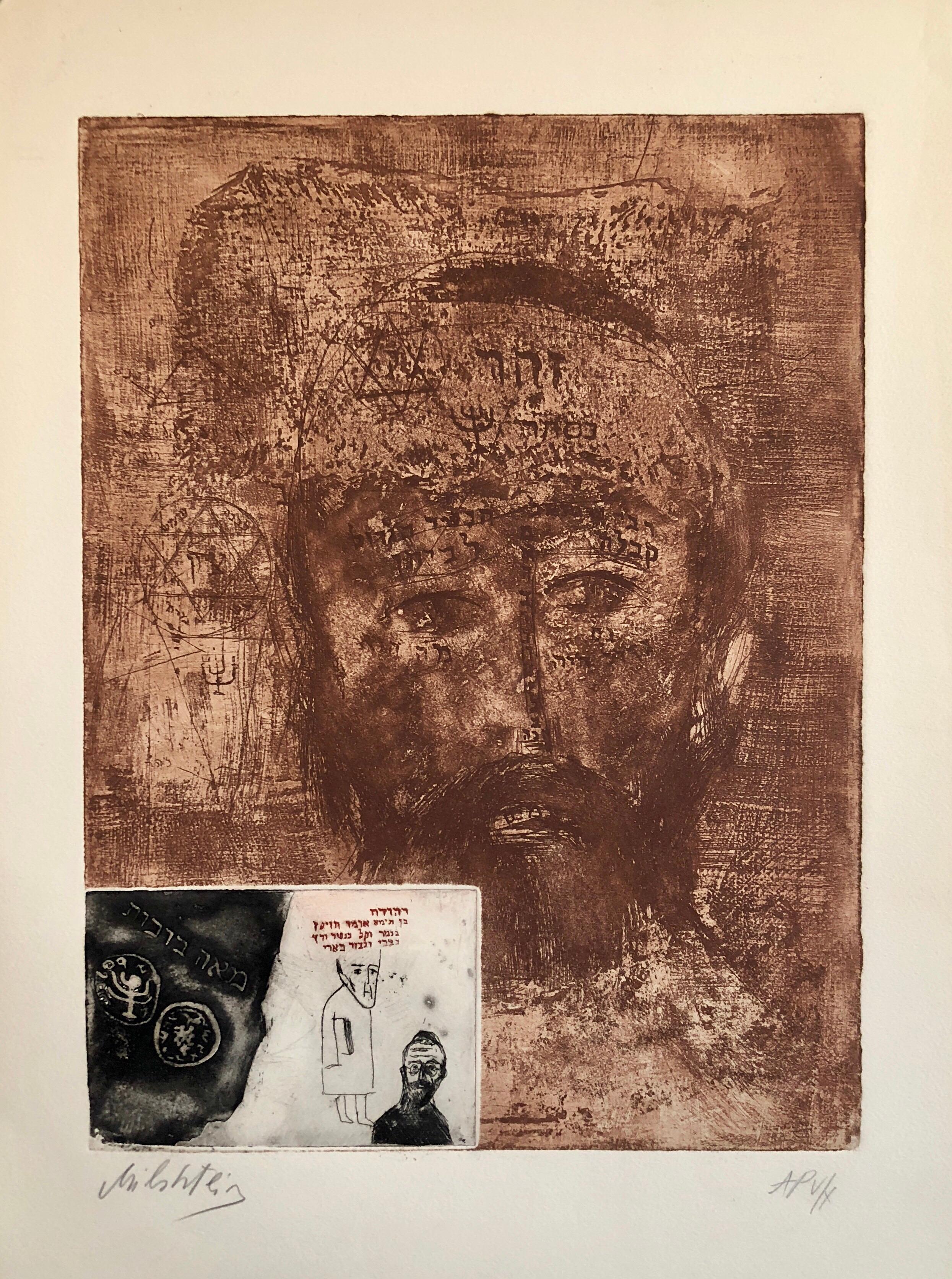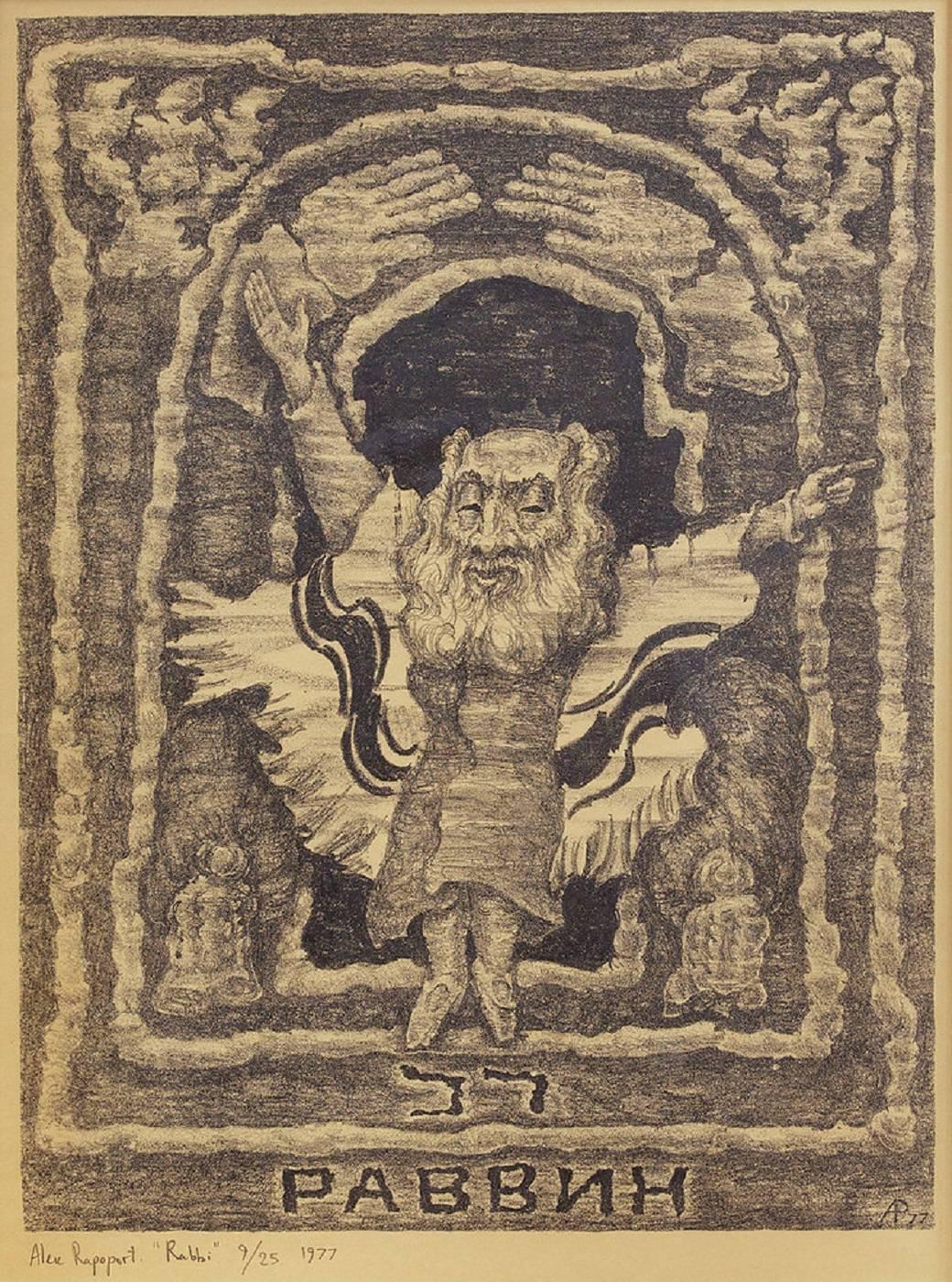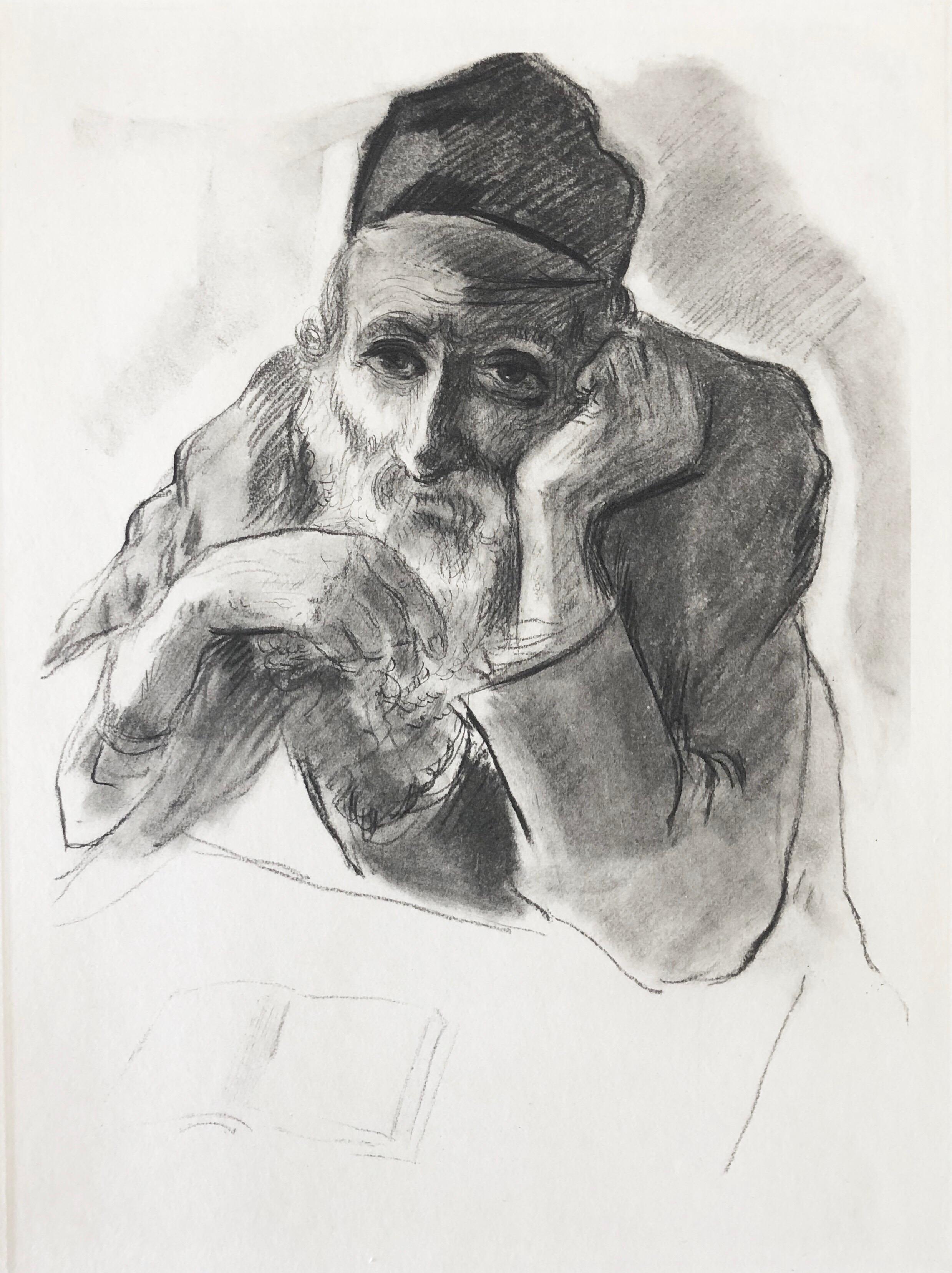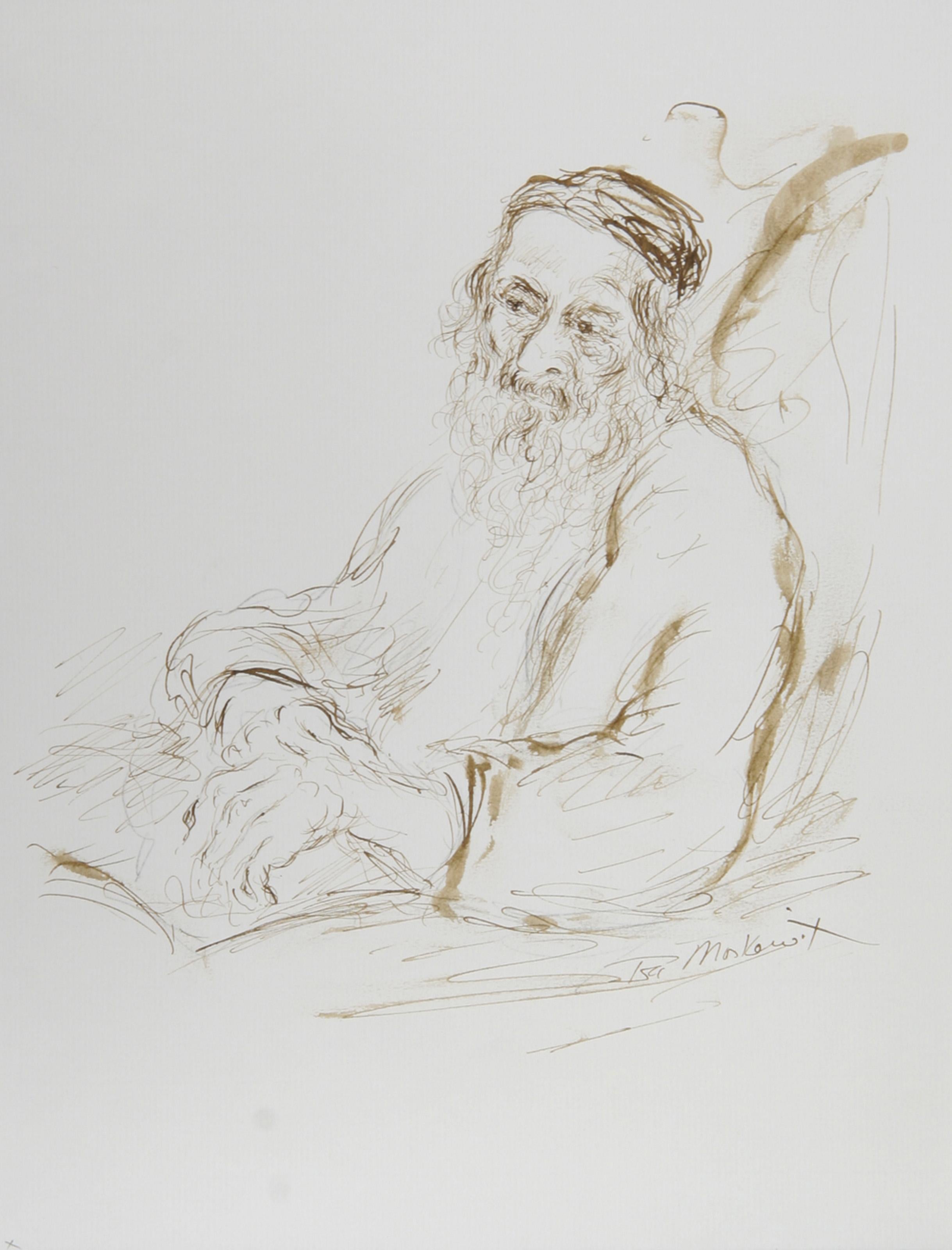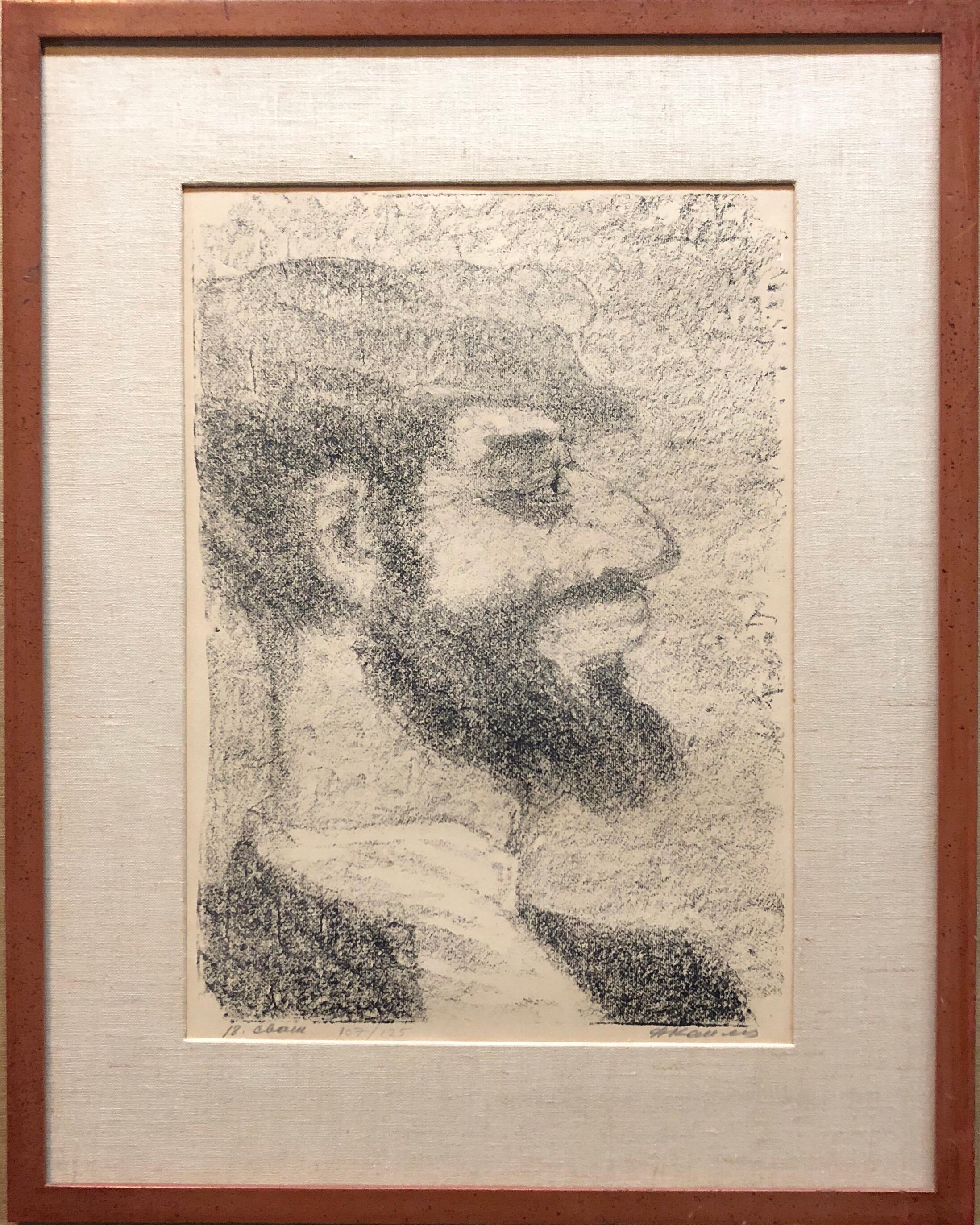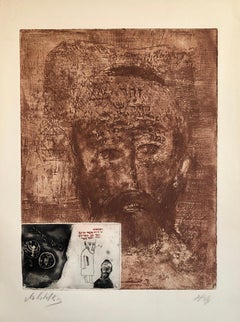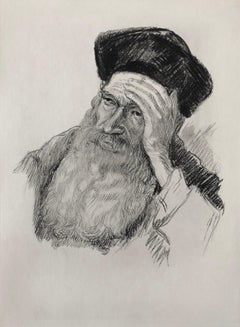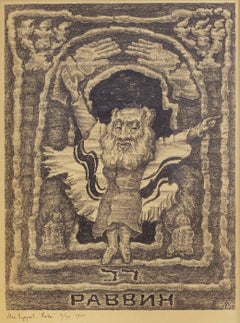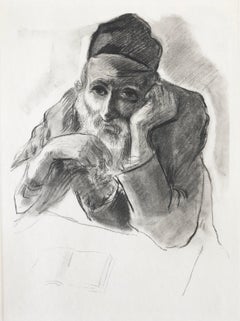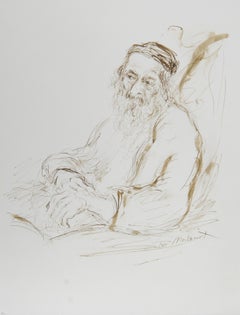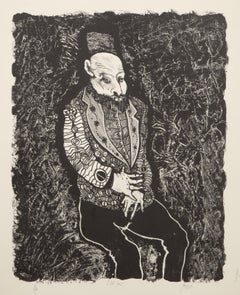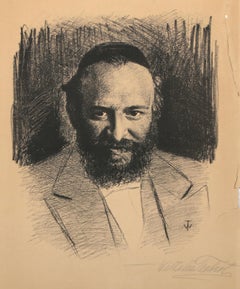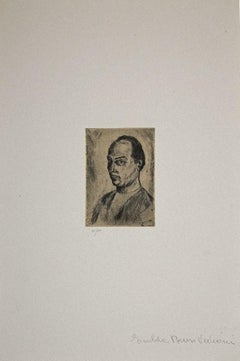Items Similar to Self Portrait Post Soviet Avant Garde Hebrew Judaica Etching Hand Colored
Want more images or videos?
Request additional images or videos from the seller
1 of 8
Eugene AbeshausSelf Portrait Post Soviet Avant Garde Hebrew Judaica Etching Hand Colored1978
1978
$500
£389.28
€442.73
CA$719.38
A$790.21
CHF 412.97
MX$9,423.88
NOK 5,229.29
SEK 4,871.52
DKK 3,308.27
About the Item
Hand-Colored Etching signed in pencil l.m. in Hebrew, l.r. in English. 3/100
Shalom from Yevgeny Abeshaus
EUGENE ABESHAUS Leningrad, Russia, b. 1939, d. 2008
Eugene Abeshaus (also spelled Evgeny Abezgauz, Евгений Абезгауз in Russian; 1939–2008) was a Jewish artist who worked in Russia (then USSR) and Israel.
Born in Leningrad to a typical intelligentsia family, Abeshaus was educated as an electrical engineer but soon abandoned this career and enrolled in the Mukhina School for Applied Art. By the time of his graduation from the famous “Mukha” (Fly in Russian), he had already developed a critical stance towards the official Soviet art dominated by the Communist ideology and began exhibiting at semi-underground exhibitions. This was culminated by his taking part in a famous 1975 exhibition at the Nevsky Palace of Culture. Abeshaus was fired from his job and censured by the official press – which however admitted his "artistic taste, a good sense of color and form".
Soon afterwards, Abeshaus set up, together with several Jewish artists, the Alef Group and became its leader. The group’s first exhibition in November 1975 was held at Abeshauses’ small apartment. According to the Alef Manifesto written by Alek Rappoport, “We are trying to conquer the influence of small-town Jewish art and find sources for our work in deeper, wiser, and more spiritual European culture, and from it build a bridge to today and tomorrow".
In May 1976, some of Abeshaus’s works, clandestinely sneaked out of the country, were exhibited at the Berkeley Art Museum to much critical acclaim. Later in the same year, following some political bargain between Leonid Brezhnev and President Jimmy Carter, Abeshaus and his family were finally permitted to leave the USSR for Israel.
Since then Abeshaus lived and worked in Ein Hod, a picturesque artists’ village near Haifa founded by Marcel Janco. His works were exhibited at numerous exhibitions, including dozens one-artist shows, in Israel, USA, Europe and, after the collapse of the USSR, in Russia. His ultimate acceptance and recognition there was culminated in a sensational memorial one-artist exhibition staged in 2009 at the famous Russian Museum in St.Petersburg - an exceptional honor for a modern artist.
- Creator:Eugene Abeshaus (1939)
- Creation Year:1978
- Dimensions:Height: 15.25 in (38.74 cm)Width: 12.25 in (31.12 cm)
- Medium:
- Movement & Style:
- Period:
- Condition:Measurements include mat.
- Gallery Location:Surfside, FL
- Reference Number:1stDibs: LU38213031342
About the Seller
4.9
Platinum Seller
Premium sellers with a 4.7+ rating and 24-hour response times
Established in 1995
1stDibs seller since 2014
1,837 sales on 1stDibs
Typical response time: 1 hour
- ShippingRetrieving quote...Shipping from: Surfside, FL
- Return Policy
More From This Seller
View AllZohar Kabbalah Portrait French Jewish Surrealist Aquatint Etching Hebrew Judaica
By Zvi Milshtein
Located in Surfside, FL
Etching and Aquatint with embossing, Zwy Milshtein (Zvi Tzvi Milstein) BIOGRAPHY 1934 Born in Kishinev (Bessarabia) Russian, Romanian region.
1948 Arrived in Israel via Cyprus, wher...
Category
20th Century Expressionist Portrait Prints
Materials
Etching, Aquatint
Judaica Jewish Etching Hasidic Rabbi, Gaon, Genius, Vintage Chassidic Art Print
By Paul Jeffay
Located in Surfside, FL
"Un savant."
Chassidic scholar, Rosh Yeshiva with open book. Judaica, Jewish scenes from a shtetl ghetto.
Saul Yaffie, a.k.a. Paul Jeffay, (1898–1957) was a Scottish Jewish artist. Known for his charming French street scenes as well as his judaica work. This is signed in the plate and dated 1931 in the print. This is done in a style similar to the works of the early Bezalel School artists Hermann Struck and Jakob Steinhardt.
This lithograph, by artist Paul Jeffay depicts a Judaic Shtetl interior scene with great charm and sensitivity.
Saul Yaffie was born in Blythswood, Glasgow on 29 April 1898. His mother was Kate Yaffie (née Karkonoski), and his father, Bernard Yaffie, was a master tailor. Like many Russian Jews...
Category
20th Century Expressionist Portrait Prints
Materials
Etching
The Rabbi 1977 Soviet Non Conformist Avant Garde Print
By Alek Rapoport
Located in Surfside, FL
Dimensions w/Frame: 25 3/4" x 20 3/4"
Alek Rapoport (November 24, 1933, Kharkiv, Ukraine SSR – February 4, 1997, San Francisco) was a Russian Nonconformist artist, art theorist and teacher.
Alek Rapoport spent his childhood in Kiev (Ukraine SSR). During Stalin's "purges" both his parents were arrested. His father was shot and his mother spent ten years in a Siberian labor camp. Rapoport lived with his aunt. At the beginning of World War II, he was evacuated to the city of Ufa (the Bashkir Autonomous Soviet Socialist Republic). A time of extreme loneliness, cold, hunger and deprivation, this period also marked the beginning of Rapoport's drawing studies.
After the war, Rapoport lived in Chernovtsy (Western Ukraine), a city with a certain European flair. At the local House of Folk Arts, he found his first art teacher, E.Sagaidachny (1886–1961), a former member of the nonconformist artist groups Union of the Youth (Soyuz Molodyozhi) and Donkey's Tail, popular during the 1910s–1920s. His other art teacher was I. Beklemisheva (1903–1988). Impressed by Rapoport's talent, she later (1950) organized his move to Leningrad, where he entered the famous V.Serov School of Art (the former School of the Imperial Society for the Promotion of Arts, OPKh, later the Tavricheskaya Art School).
His association with this school lasted eight years, first as a student, and then, from 1965 to 1968, as a teacher. With "Socialist realism" the only official style during this time, most of the art school's faculty had to conceal any prior involvement in non-conformist art movements. Ya.K.Shablovsky, V.M.Sudakov, A.A.Gromov introduced their students to Constructivism only through clandestine means.
(1959–1963) Rapoport studied stage design at the Leningrad Institute of Theater, Music and Cinema under the supervision of the famous artist and stage director N.P.Akimov. Akimov taught a unique course based on theories of Russian Suprematism and Constructivism, while encouraging his graduate students to apply their knowledge to every field of art design. Despite differences in personal artistic taste with Akimov, who was drawn to Vermeer and Dalí, Rapoport was influenced by Akimov's personality and liberalism, as well as the logical style of his art.
In 1963, Rapoport graduated from the institute. His highly acclaimed MFA work involved the stage and costume design for I.Babel's play Sunset. In preparation, he traveled to the southwest regions of the Soviet Union, where he accumulated many objects of Judaic iconography from former ghettos, disappearing synagogues and old cemeteries. He wandered Odessa in search of Babel's characters and the atmosphere of his books.
He organized a new liberal course in technical aesthetics, introducing his students to Lotman's theory of semiotics, the Modulor of Le Corbusier, the Bauhaus school, Russian Constructivism, Russian icons and contemporary Western art. As a result of his "radicalism," Rapoport was fired for "ideological conspiracy."
He sought to cultivate himself as Jewish artist. This became particularly noticeable after the Six-Day War, when the Israeli victory led intellectuals, including the Jewish intelligentsia, to feel a heightened interest in Jewish culture and its Biblical roots. Rapoport's works of this period include Three Figures, a series of images of Talmudic Scholars, and works dealing with anti-Semitism. In the 1970s Rapoport joined the non-conformist movement, which opposed the dogmas of "Socialist realism" in art, along with Soviet censorship. The movement sought to preserve the traditions of Russian iconography and the Constructivist/Suprematist style of the 1910s. Despite the authorities' persecutions of nonconformist artists (including arrests, forced evictions, terminations of employment, and various forms of routine hassling), they united in a group, "TEV – Fellowship of Experimental Exhibitions." TEV's exhibitions proved tremendously successful.
In the same period, Rapoport became one of the initiators of another anti-establishment group, ALEF (Union of Leningrad's Jewish Artists). In the United States this group was known as "Twelve from the Soviet Underground." Rapoport's involvement with this group increased tension with the authorities and attracted KGB scrutiny, including "friendly conversations," surveillance, detentions and house arrests. It became increasingly dangerous for him to live and work in the USSR. In October 1976, Rapoport with his wife and son were forced to leave Russia.
In Italy, Rapoport exhibited at the Venice Biennale, "La Nuova Arte Sovietica-Una prospettiva non-ufficiale" (1977), participated in television programs about nonconformist art in the Soviet Union, and created lithographic works continuing his theme of Jewish characters from Babel's play Sunset.
In 1977, Rapoport's family was granted U.S. immigration status and settled in San Francisco. a significant event in Rapoport's life occurred in his meeting with San Francisco gallery owner Michael Dunev, who became his friend and representative, organizing all his exhibitions until the artist's death.
Toward the end of the 1980s and beginning of the 1990s, Rapoport completed his most ambitious works on the theme of the Old Testament prophets: Samson Destroying the House of the Philistines (1989), Lamentation and Mourning and Woe (1990), the four paintings Angel and Prophets (1990–1991) and Three Deeds of Moses (1992).
In 1992, the artist's friends in St. Petersburg organized the first exhibition of his works there since his departure into exile, with works patiently gathered from collectors and art museums. This exhibition, held in the City Museum of St. Petersburg and accompanied by headlines such as "A St. Petersburg artist returns to his town," was followed by much larger ones in 1993 (St. Petersburg and Moscow), organized in collaboration with Michael Dunev Gallery under the name California Branches – Russian Roots.
He Exhibited in "Soviet Artists, Jewish Themes...
Category
1970s Post-Modern Figurative Prints
Materials
Lithograph
Judaica Jewish Shtetl Etching Hasidic Rabbi Meditation Vintage Chassidic Print
By Paul Jeffay
Located in Surfside, FL
"Meditation."
Chassidic boy, Yeshiva student with open book. Judaica, Jewish scenes from a ghetto.
Saul Yaffie, a.k.a. Paul Jeffay, (1898–1957) was a Scottish Jewish artist. Known ...
Category
20th Century Expressionist Figurative Prints
Materials
Etching
Vintage Russian Shtetl, Scene Judaica Lithograph Jewish Portrait
By Anatoli Lvovich Kaplan
Located in Surfside, FL
Pencil signed and dated, Judaica Lithograph.
Anatoli Lwowitch Kaplan was a Russian painter, sculptor and printmaker, whose works often reflect his Jewish origins.
His father was a b...
Category
Mid-20th Century Modern More Prints
Materials
Lithograph
Hungarian Modernist Judaica Etching Print Kiddush, Jewish Rabbi at Shabbat Feast
By Janos Kass
Located in Surfside, FL
From very small edition of 15 on handmade mould made paper, with Jewish star Magen David watermark. From the deluxe boxed portfolio edition.
János Kass (...
Category
1990s Expressionist Figurative Prints
Materials
Etching
You May Also Like
Rabbi with Book - I, Folk Art Ink on Paper by Ira Moskowitz
By Ira Moskowitz
Located in Long Island City, NY
Ira Moskowitz, Polish/American (1912 - 2001) - Rabbi with Book - I, Year: circa 1989, Medium: Ink on Paper, signed, Size: 13 in. x 10 in. (33.02 cm x 25.4 cm), Description: Placing ...
Category
1980s Folk Art Portrait Drawings and Watercolors
Materials
Ink
Old Jew, Surrealist Lithograph by Peter Paone
Located in Long Island City, NY
Peter Paone, American (1936 - ) - Old Jew, Year: circa 1963, Medium: Lithograph on Rives, signed, titled and numbered in pencil, Edition: 11/50, Image Si...
Category
1960s Surrealist Portrait Prints
Materials
Lithograph
Portrait of Nehemias Anton Nobel, Modern Lithograph by Wilhelm Taubert
Located in Long Island City, NY
Wilhelm Taubert, German (1811 - 1891) - Portrait of Nehemias Anton Nobel, Year: circa 1900, Medium: Lithograph, signed in pencil, Image Size: 13 x 11 inches, Size: 18 x 14 in. (4...
Category
Early 1900s Modern Portrait Prints
Materials
Lithograph
Self-Portrait - Original Etching by Giuseppe Viviani - 1983 (1931)
By Giuseppe Viviani
Located in Roma, IT
Self-portrait is an original etching realized by Giuseppe Viviani on plate in 1931.
In 1983 a 100-piece edition was made, all signed by the widow of the artist Signora Eralda Benso ...
Category
1930s Modern Figurative Prints
Materials
Etching
Portrait - Original Etching by Leo Guida - 1970s
By Leo Guida
Located in Roma, IT
Portrait is an original etching realized in the 1970s by the Italian Contemporary artist Leo Guida (1992 - 2017).
Good conditions.
Leo Guida (1992 - 2017). Sensitive to current ...
Category
1970s Contemporary Figurative Prints
Materials
Etching
Challah, Folk Art Etching with Aquatint by Ira Moskowitz
By Ira Moskowitz
Located in Long Island City, NY
Ira Moskowitz, Polish/American (1912 - 2001) - Challah, Year: circa 1970, Medium: Etching with Aquatint, signed and numbered in pencil, Edition: 45/120, Size: 10 x 11.75 in. (25.4 ...
Category
1970s Folk Art Figurative Prints
Materials
Etching
More Ways To Browse
Vermeer Lithograph
Vintage 1945 Dresses
Vintage Broadway Posters
Vintage Gun Print
William Auerbach Levy
William Lionel Wyllie
Woodcut Print Jacques
15th Century Woodcut
1978 Dali
20th Century French Woodcuts
Aldemir Martins
Ancient Greek Busts
Andrew Wyeth Signed And Numbered Prints
Andy Warhol Electric Chairs
Ben Shahn Martin Luther King
Bus Stop Sign
Cain And Abel
Calder Behind The Mirror
